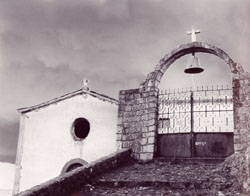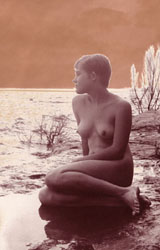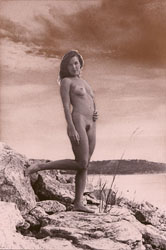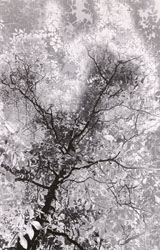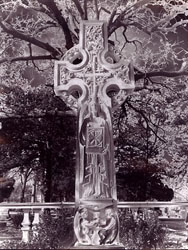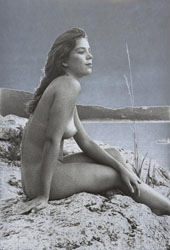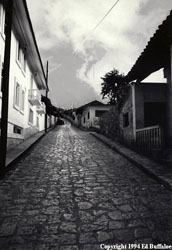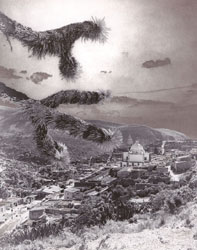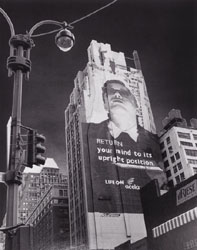 |
|||
|
|
|
II. Controlling the Variables
The paper must generally be a contrasty bromide emulsion. Universally recommended were the higher contrast grades of Agfa Brovira. Unfortunately, this paper is no longer available—it was far and away the best paper for print solarization. Other papers which solarize are Ilford Ilfobrom Galerie FB, Forte Bromofort, and Luminos Classic cool tone fiber base. The most contrasty grade (4 or 5) is typically used for very dramatic posterization-like effects, whereas grades 3, and in rare instances 2, are used to achieve more subtle results. William Jolly’s experiments indicate that there are some mixed-emulsion papers that solarize well, and two such are Luminos Classic warm tone fiber base (grade 2.5 only), and Bergger Prestige CB Art (grades 2, 3, and 4), which have many of the properties of a bromide paper (such as solarizing well), but which respond to gold toning like a chloride paper.
Walker and Rainwater recommended the use of old, much used Dektol in their book Solarization (1974) (which probably worked because the hydroquinone was exhausted) but later invented the Solarol formula, which I have found to be nearly identical in use to Ansco 120. William Jolly gives the formula he uses, which is quite similar to Ansco 120. In the late 1990’s, Clarence Rainwater created his R77 solarizing developer, which contains phenidone and pyrocatechin. Metol can be substituted for the phenidone, if necessary, in 10X quantities by weight, giving R77M, a superb solarizing formula.
The temperature of the developer must not be much above 65-70º Fahrenheit (18-21º C), or unwanted fog will result. In the summer in Texas I buy a bag of crushed ice and surround the developer tray with it, and often dilute the developer with cold water. The initial exposure is usually somewhat less (one quarter to one-half stop) than that necessary to produce a deep black when developed for half the normal time. This first exposure determines the level of original low values that will appear as black in the final print, as well as which portion of the image will reverse. If the first exposure is increased too much, there will be no Sabatier reversal at all. In such a case, the second exposure merely serves to reduce overall paper contrast. If the initial exposure is considerably reduced the image may be completely reversed during solarization, the high values fogging and the low values reversing and becoming white.
The light source is generally a frosted incandescent light bulb, preferably in some sort of reflector that will evenly illuminate the developer tray, and placed three or four feet above it. A switch for the light is necessary. An electronic timer with a footswitch would be ideal, but is not essential. I keep an array of different incandescent bulbs for solarization, from 7.5 Watts up to 250 Watts. The R77 developer generally requires a much stronger light source for the solarization exposure than metol-based developers. I try to keep the second exposure in the 1 to 10 second range, but exposure time may be extended to several minutes if the light source is weak. The least exposure will produce only a very slight density increase in the high values, where it may illuminate detail which might otherwise be lost. Lengthy exposures will produce deep grey or black in what would otherwise have been highlights, and, up to a point, may increase the reversal effect in certain middle print values. Obviously, with a brighter light source less exposure is required. I find it is usually helpful to lift the print out of the developer and float it on the surface just before making the solarization exposure.
The contrast grade of the paper is an important consideration for interpretive reasons. Hard papers are typically used when very dramatic high contrast effects are desired. Softer grades are progressively more subtle, and can be used to make prints that may not even look solarized. For example, a low-contrast negative may have excellent shadow detail, but the high values might be degraded and print as shades of grey. A very light solarization exposure on a grade 3 paper will cause these grey values to reverse (actually they are desensitized to development), in many cases without affecting any other portion of the print, giving the appearance of a normally exposed and developed print. The lower the contrast grade of the paper, the less light is required to solarize it.
Image warmth may also be controlled to some extent by changing developer dilution. The greater the dilution, the greater the warmth of the resulting image. The intensity of the light source, as well as the length of the second exposure, affect how dark the fogging effect in the high values is: the brighter the light source, the darker the resulting tone. They also affect how much reversal will take place. A less intense light source may not produce as clean a reversal effect as a bright source. However, too bright a source will fog the entire paper. If developer dilution is increased, or bromide content is increased, a brighter light source is often required. When using very high bromide developers, it may be necessary to use a 200 to 250 watt light bulb in order to get good reversal effects. An ideal situation would be a very bright bulb attached to a rheostat, so that the desired illumination level could be chosen as required. Different paper brands, as well as different paper grades and different developers, often require different light intensities for optimal solarization. III. Practical Procedures
With experience and care, one can achieve reasonable consistency. To begin with, change one variable at a time. Choose a developer with a couple of grams of bromide per liter and make a working solution. Use a single light source, such as a 60 watt bulb at about 4 feet from the developer tray, and use a set time for the solarization exposure--start with 5 seconds. Adjust the initial exposure for the ratio of low values to reversed areas, and the solarization exposure for the amount of fogging you wish to take place in what would otherwise be high values in the print. If you don't get good blacks, increase the initial exposure. If you don't get enough reversal, increase the length or intensity of the second exposure and be sure to develop fully. If you don't get any reversal at all and the print looks normal or overexposed, reduce the initial exposure by a full f-stop and repeat your test.
A number of significant variations on the solarization exposure have been recorded--such as making the second exposure through the enlarger with a negative in it. The same negative may be used as for the first exposure, producing interesting edge effects; or another negative may be used to introduce a different image into areas of the print not developed out prior to solarization. If the same negative is used for the second exposure, print alignment becomes an important factor. In either case, you will find it necessary to remove the print from the developer and squeegee it for the solarization exposure. Another variation is to presoak the paper for several minutes in a concentrated developer solution, then squeegee and place under the enlarger—after the first exposure you can watch the print develop out, and after the second exposure you can watch it solarize. You may re-expose if the second exposure was insufficient to induce solarization. IV. Duotone Effects
When utilizing a high bromide developer it is necessary to use a much brighter light source for the solarization exposure, since bromide tends to reduce emulsion speed. This is where high-wattage bulbs are necessary. Remember that better results are often obtained with brighter light sources rather than longer exposures. Bromide streaks are common due to the very intense development after the second exposure: to eliminate these, remove from the first developer and soak in a tray of running water for 30 seconds before placing the print in the second developer tray. Allow the print to settle and the developer to become completely still before solarizing, then allow development to finish without agitation. The print may need to stay in the second developer for as long as two or three minutes.
The more variables one introduces into the process, the greater the number of failures one is liable to generate and the greater is the potential for unexpected results. By the same token, you are also increasing the possibility that you will obtain an unique effect. Increasing the bromide concentration may require adjusting the initial exposure time, the initial developing time, the intensity of the second exposure, the length of the second exposure, or the length of final development, any of which changes may require further adjustments. The high values of solarized prints (i.e., those areas that reverse when solarized) are usually somewhat degraded during the reversal process, and should be reduced in a highly diluted ferricyanide reducer. Use the formula for prints--you may wish to dilute it more than normal. Beware of over-bleaching, but also take into account the fact that prints will dry down considerably—they must be reduced to the point of "apparent" over-bleaching, or you may well be disappointed when they dry. Once the prints have been toned, they should not be reduced again, but it is perfectly feasible to let a print dry to see how the high values look before toning. After reduction, the print should be agitated in rapid fixer for 30 seconds before toning. Iodine bleach may also be used for a minute or two at a dilution of 1:100. Be sure to fix thoroughly, as silver iodide is more difficult to remove. VI. Toning The print may be toned in selenium (1:15 or stronger) or Kodak Polytoner (1:15) for brown or purple tones, or in a thiocyanate-based gold toner for blue tones. With Brovira, prints could be given lengthy toning times, even with the duotone process. However, with other papers I find that a long toning time tends to reduce duotone separation. Toner dilution may be decreased to enable shorter toning times with some papers (particularly Ilford Ilfobrom Galerie).
Solarization and the Sabattier Effect contains some interesting variations on the process.
|
|||||||||||||||||||||||||||||||||||||||||||||||||||||||||||||||||||||||||||||
|
|
|
|
